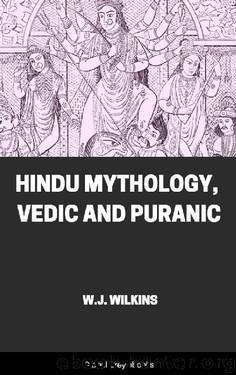Hindu Mythology, Vedic and Puranic by W.J. Wilkins

Author:W.J. Wilkins [Wilkins, W.J.]
Language: eng
Format: epub, pdf
Publisher: Global Grey ebooks
Published: 2019-02-26T00:00:00+00:00
Chaitanya
Chaitanya is believed by his followers to have been an incarnation of Vishnu; and as he lived in historical times, about 300 years ago, it is interesting to notice how a human being came to be regarded as divine. He is worshipped in Nadiya in Bengal, and it is a singular fact, that, at his shrine, there is a very small image of Krishna, of whom he was a disciple and apostle, whilst the image of Chaitanya is large and conspicuous. The Hindus who acknowledge this god say that, amongst the many incarnations of Vishnu, four are most important. The first, in the Satya-yuga, called the Suklavarna (the white), was Ananta; the second, in the Treta-yuga, called the Raktavarna (the red), was that of Kapiladeva; the third, in the Dwārpara-yuga, called the Krishnavarna (the black), was Krishna; and the last, in the Kāli-yuga, called the Pitavarna (the yellow), was Chaitanya.
The founder of the sect, of which Chaitanya was the most illustrious member, was a Brāhman named Adaitya, who lived at Santipore in Bengal. Another leader, named Nityananda, was born at Nadiya a short time before Chaitanya. Chaitanya's father was a Brāhman, named Jagannāth Misra; his mother's name was Suchi; their first son, Visvambhara, was a religious mendicant. When their renowned son was born, his mother was rather old; and as the child seemed weak, in accordance with a custom which prevailed in those times, he was hung in a basket on a tree to die. Adaitya happening to pass by the house at the time, imagining that the child thus exposed might be the incarnation of deity he was expecting, and which he had foretold, wrote with his foot on the soft earth the incantation employed at the initiation of a disciple into the mysteries of the worship of Krishna. The mother, impressed by this act, lifted the child from the tree, who immediately took kindly to his food, which he had before neglected, and showed signs of strength and vigour.
Chaitanya made great progress in learning. At sixteen he married Vishnupriyā, with whom he lived until he was forty-four years of age, when he was persuaded by Adaitya and other mendicants to renounce his poitā (Brāhmanical thread) and join them in their religious life. This was to lose his high position as a Brāhman. Leaving home, parents and wife, he removed to Benares, and many thought him guilty of a great crime in forsaking a large family that was dependent upon him for support. On his arrival at that city he began to teach the doctrines of his sect and gathered many disciples. He called them Vaishnavas—worshippers of Vishnu—and although his teaching was diametrically opposed in many important matters to orthodox Hinduism he was eminently successful. Many who had formerly chiefly worshipped Siva and other deities, adopting his teaching, made Krishna the supreme. The main tenets of his teaching were these: That men should renounce a secular life, and spend their time in visiting shrines; that they abandon the distinctions
Download
Hindu Mythology, Vedic and Puranic by W.J. Wilkins.pdf
This site does not store any files on its server. We only index and link to content provided by other sites. Please contact the content providers to delete copyright contents if any and email us, we'll remove relevant links or contents immediately.
Cecilia; Or, Memoirs of an Heiress — Volume 1 by Fanny Burney(32437)
Cecilia; Or, Memoirs of an Heiress — Volume 2 by Fanny Burney(31873)
Cecilia; Or, Memoirs of an Heiress — Volume 3 by Fanny Burney(31857)
The Great Music City by Andrea Baker(31488)
We're Going to Need More Wine by Gabrielle Union(18972)
All the Missing Girls by Megan Miranda(15588)
Pimp by Iceberg Slim(14398)
Bombshells: Glamour Girls of a Lifetime by Sullivan Steve(13977)
Talking to Strangers by Malcolm Gladwell(13229)
Norse Mythology by Gaiman Neil(13211)
Fifty Shades Freed by E L James(13159)
For the Love of Europe by Rick Steves(13056)
Mindhunter: Inside the FBI's Elite Serial Crime Unit by John E. Douglas & Mark Olshaker(9206)
Crazy Rich Asians by Kevin Kwan(9170)
The Lost Art of Listening by Michael P. Nichols(7411)
Enlightenment Now: The Case for Reason, Science, Humanism, and Progress by Steven Pinker(7239)
The Four Agreements by Don Miguel Ruiz(6636)
Bad Blood by John Carreyrou(6558)
Weapons of Math Destruction by Cathy O'Neil(6148)
